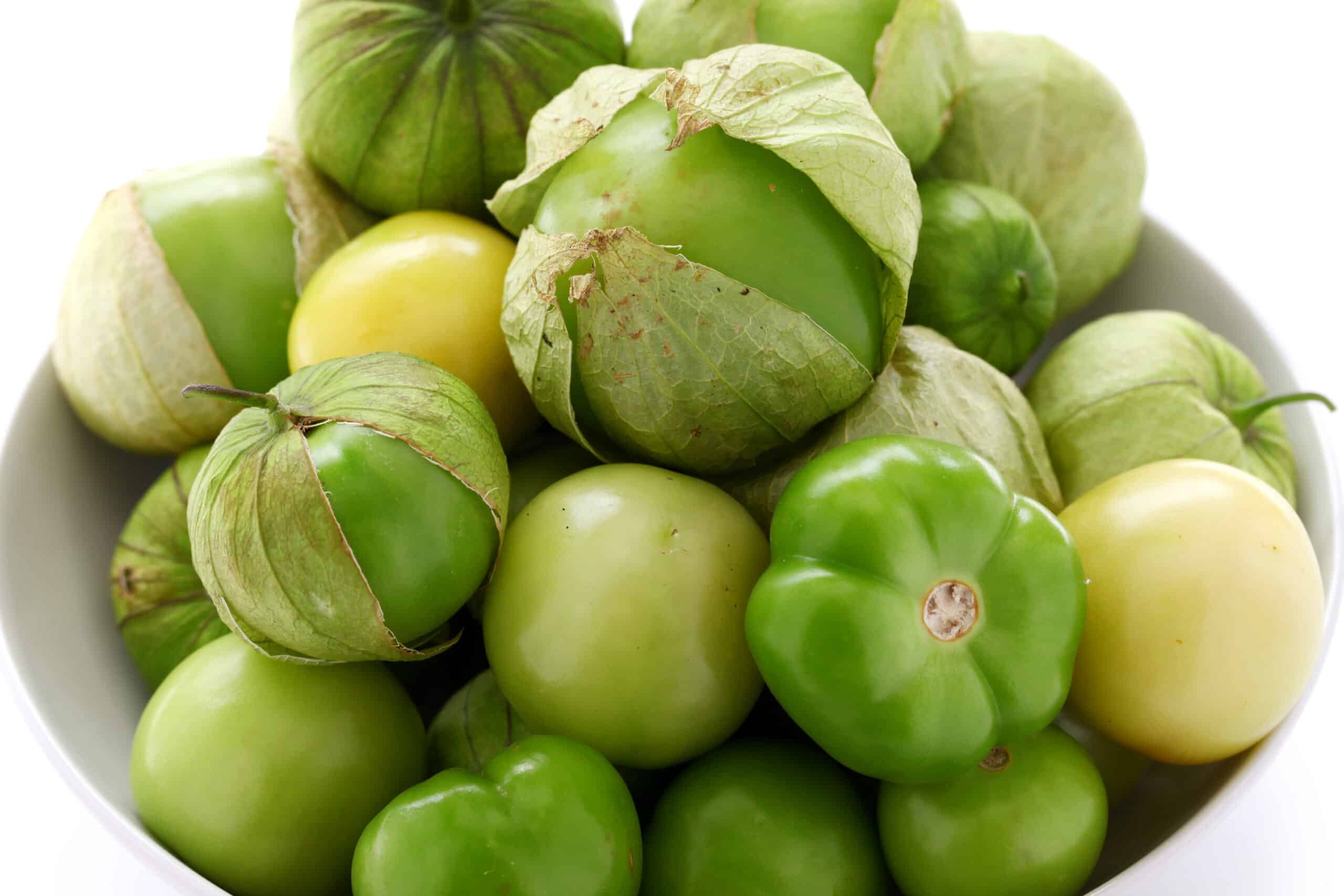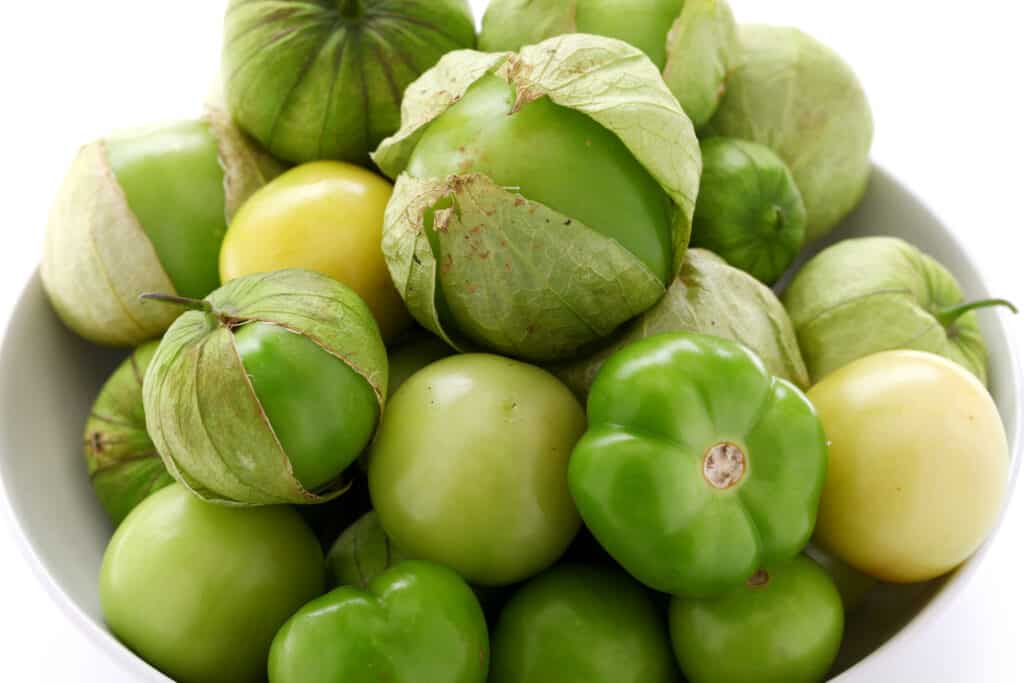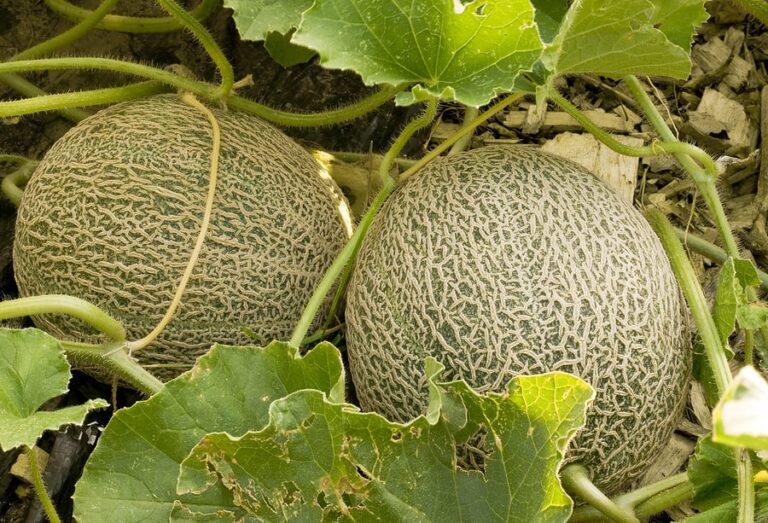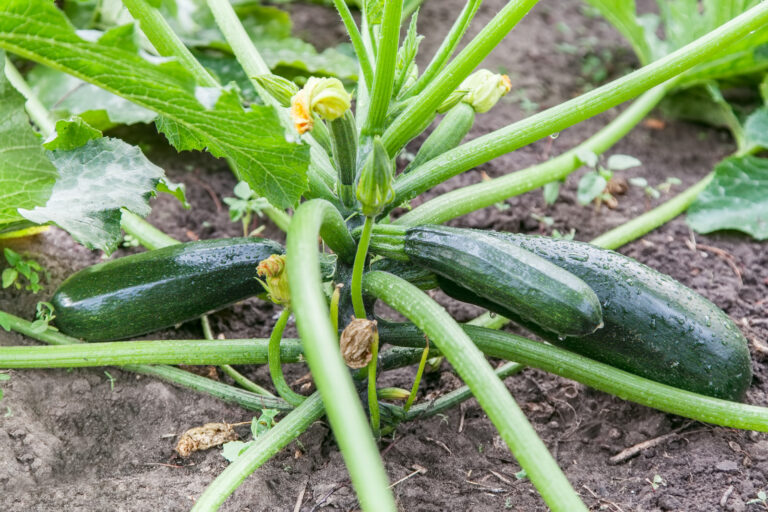Tasty Ways to Cook and Serve Tomatillos
Tomatillo flavor is delicate but slightly tart in a green tomato sort of way, although it can sometimes border on sweet. Some say the flavor of the tomatillo is a combination of apple, lemon, and herbs.
Tomatillo can be sliced raw into a salad or diced into salsa. Most often tomatillo is slowly simmered until soft, puréed, and added with onions and peppers to make the green sauce called salsa verde.
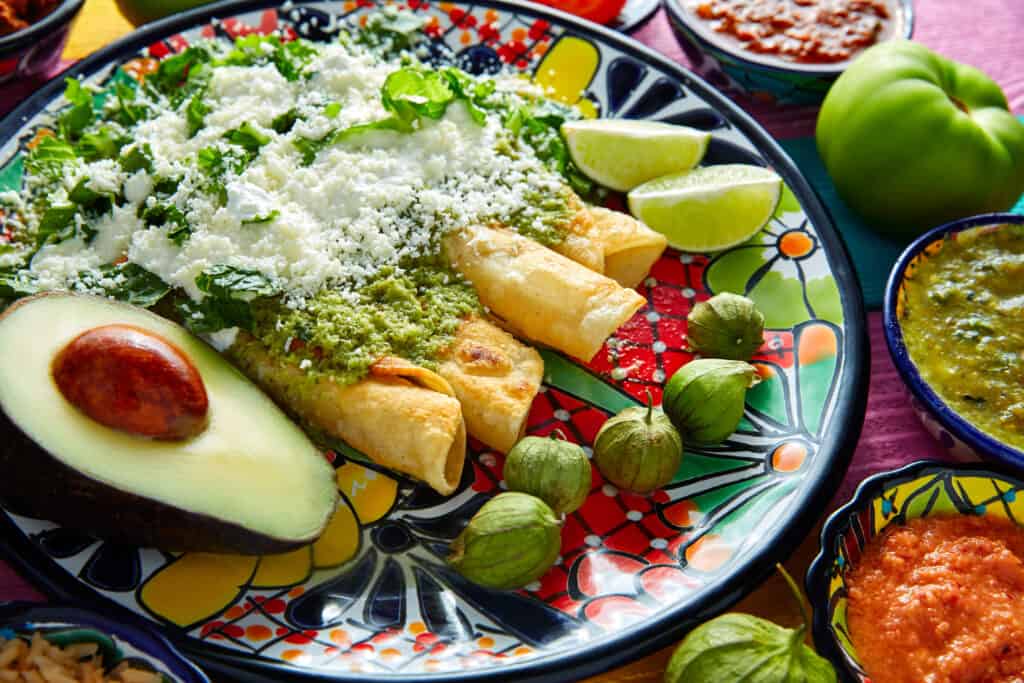
When ripe the color of the tomatillo’s skin will turn to yellow or purple, but you can use it green.
The tomatillo is a mid- to late-summer vegetable.
Kitchen Helpers from Amazon:
- Oster Vegetable Steamer
- Chef’s Knives Set of 6
- EZ Off Jar Opener for Weak Hands
- Pepper Core Remover Stainless Steel
- Kitchen Utensils – Set of 35
How to choose tomatillos
- Select tomatillos that are firm, unblemished, and evenly colored. The husk should be tight-fitting, free of mold, and crisp.
How to store tomatillos
- Tomatillos will keep for 2 days at room temperature and for 1 week in the vegetable drawer of the refrigerator.
- You can freeze tomatillos after cooking.
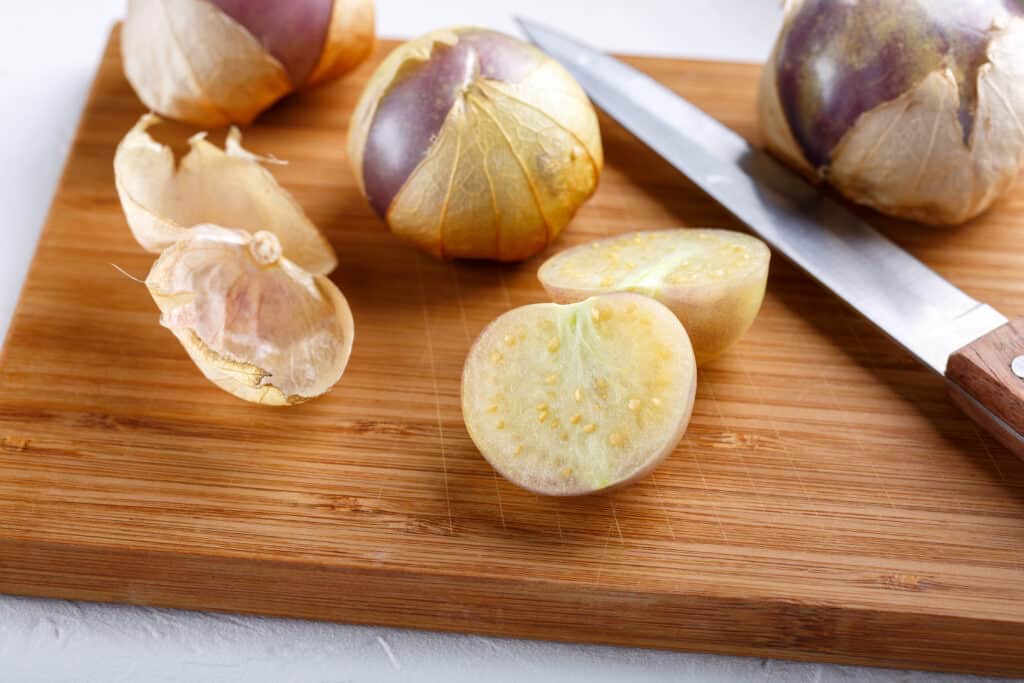
How to prep tomatillos
- To use the tomatillo, first, peel off the husk and wash it, particularly any sticky resin that you might find at the base of the stem.
- Remove the core before slicing the tomatillo raw onto salads or into salsas.
- Tomatillo is made into a green sauce—called salsa verde—served on enchiladas and Mexican pork stews.
How to serve tomatillos
- Use the tomatillo raw or cooked.
- Add tomatillo sliced raw onto a salad or mince raw and add to gazpacho, salsa, or guacamole.
How to cook tomatillos
- Cooking will enhance the flavor and soften the tomatillo’s thick skin.
- Simmer the tomatillo in water for about 10 minutes until the skin is soft and easily pierced with a knife.
- Simmer the tomatillo with onion and garlic till soft and then blend to make enchilada sauce.
- Salsa verde is made of ground tomatillos, onion, and chiles.
- Use the tomatillo-based sauce to season tacos, burritos, enchiladas, and meats.

How to make salsa verde
- Preheat the oven to 400 degrees F.
- Place the tomatillos on a baking sheet and roast until the skins are light brown and blistered, about 20 minutes. (You will need about a dozen tomatillos.)
- Chop onions and mince garlic while the tomatillos are roasting.
- Let the tomatillos sit until they are cool then chop them finely; you can also chop and add mild green chiles.
- Add a bit of olive oil to a large deep skillet over medium heat and when hot add the onions and garlic and sauté until soft and lightly brown, about 10 minutes.
- Add the chopped tomatillos and peppers a cup of vegetable stock and salt and pepper to taste and stir bringing to a low simmer.
- Cook until the mix is slightly thickened, about 10 to 15 minutes.
- Stir in fresh chopped cilantro and a bit of lime juice; taste and adjust the seasoning.
- Serve at room temperature.
How to make green enchilada sauce
- Follow the directions above.
- When finished use an immersion blender to purée the sauce.
Tomatillo flavor partners
- Tomatillo has a flavor affinity for cilantro, cucumber, green chile peppers, grilled foods, lime, pumpkin seeds, tequila, tomatoes, and onion.
Tomatillo nutrition
- Tomatillos are a good source of potassium and contain vitamin C, magnesium, niacin, and thiamine.
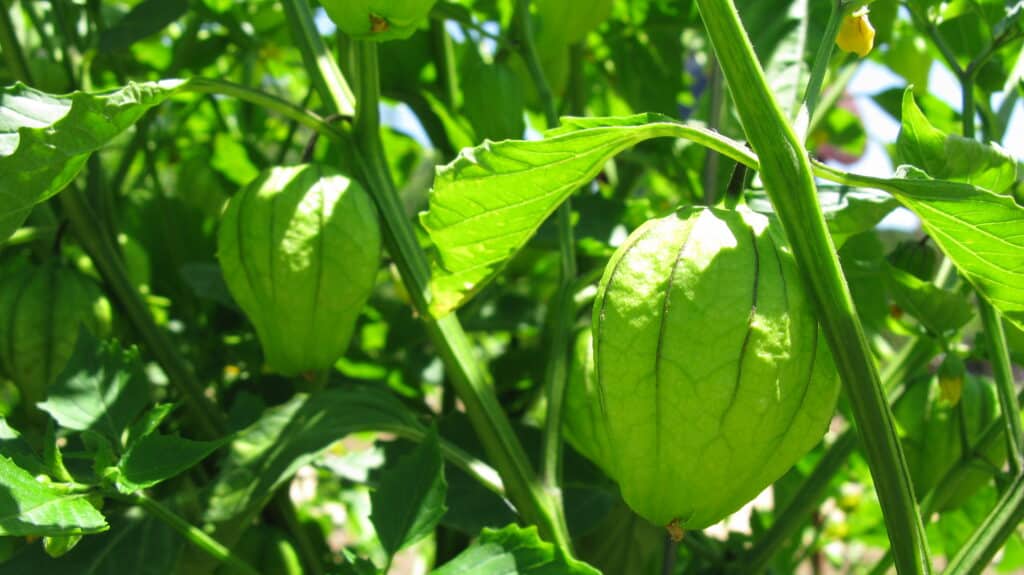
Get to know tomatillos
- Tomatillo means “little tomato” in Spanish.
- The tomatillo plant grows from 3 to 4 feet (.9-1.2 m) tall. The papery husk or membrane that covers the tomatillo’s berry is actually a calyx or flower part. The husk splits when the tomatillo ripens and turns a brownish-orange color but never falls off. The tomatillo is also sometimes called the Mexican husk tomato.
- The tomatillo is a relative of the tomato, eggplant, pepper, and potato. Its fruit is actually a berry and grows from 1 to 2 inches (2.5-5 cm) in diameter. It is smaller, more firm, and glossier than the tomato.
- The interior flesh of the tomatillo is usually pale yellow with a gelatinous texture and contains dozens of tiny seeds.
- The tomatillo is native to Mexico.
- The Aztecs and Mayans considered the tomatillo a staple in their cookery.
The botanical name for the tomatillo is Physalis ixocarpa.
Tomatillo Learning Hub
Start Here
Planning, Timing & Varieties
- When and How to Plant Tomatillos for Maximum Yield
- Tomatillo Planting Calendar: Month-by-Month Guide
- Tomatillo Seed Starting Tips
- Best Tomatillo Varieties for Home Gardens
- Short-Season and Fast-Maturing Tomatillos
Planting & Early Growth
Watering, Feeding & Seasonal Care
- Watering and Feeding Tomatillos: How to Boost Fruit Production
- Tomatillo Plant Care: Pruning, Supporting, and Seasonal Tips
Pests, Diseases & Natural Control
Harvest and Kitchen
Related articles:
How to Plant and Grow Tomatillos
How to Harvest and Store Tomatillos
Tasty Ways to Cook and Serve Tomatillos
Articles of interest:
Best Herbs for Container Growing
Garden Planning Books at Amazon:
- Vegetable Garden Almanac & Planner
- Kitchen Garden Grower’s Guide Vegetable Encyclopedia
- Vegetable Garden Grower’s Guide
- Tomato Grower’s Answer Book
More kitchen tips:
Bring your harvest to the table. Kitchen prep tips and easy recipes for the vegetables you grow. Click below for vegetable prep and recipes you can use now.
- Almonds
- Apples
- Apricot
- Aprium
- Artichoke
- Arugula
- Asparagus
- Avocado
- Bamboo Shoots
- Banana
- Basil
- Beans, Dried
- Beans. Long
- Beans, Shell
- Beans, Snap
- Beets
- Bitter Melon
- Blackberry
- Bok Choy
- Broccoli
- Broccoli Raab
- Brussels Sprouts
- Cabbage
- Cardoon
- Carrots
- Cauliflower
- Celeriac
- Celery
- Chard
- Chayote Squash
- Cherimoya
- Cherries
- Chestnut
- Chickpea
- Chinese Cabbage
- Chives
- Cilantro
- Citron
- Clementine
- Collards
- Coriander
- Corn, Sweet
- Corn, Baby
- Corn Salad, Mache
- Cranberry
- Cress
- Cucumber
- Daikon
- Dandelion
- Dill
- Eggplant
- Endive, Belgian
- Endive and Escarole
- Fava Beans
- Fig
- Florence Fennel
- Garlic
- Ginger
- Grapefruit
- Grapes
- Guava
- Horseradish
- Jerusalem Artichoke
- Jicama
- Jujube
- Kale
- Kiwifruit
- Kohlrabi
- Kumquat
- Leeks
- Lemongrass
- Lemons
- Lettuce
- Lime
- Mache (Corn Salad)
- Mandarin Orange
- Mango
- Maple Syrup
- Marjoram
- Melons
- Michihili
- Mint
- Mizuna
- Mushrooms
- Mushrooms, Cremini
- Mustard Greens
- Napa Cabbage
- Nectarine
- Okra
- Olives
- Olive oil
- Onions
- Oranges
- Oregano
- Parsley
- Parsley Root
- Parsnips
- Passion Fruit
- Pawpaw
- Peaches
- Pears
- Peas, Garden Snap
- Peas, Snow
- Pei Tsai
- Peppers, Chili
- Peppers, Sweet
- Persimmon
- Pineapple
- Pineapple Guava
- Plantain
- Plums
- Pluots
- Pomegranate
- Potatoes
- Prickly Pear
- Pumpkin
- Quince
- Radicchio
- Radishes
- Raspberries
- Rosemary
- Rhubarb
- Rutabaga
- Sage
- Salsify
- Sauerkraut
- Savory
- Shallots
- Sorrel
- Spinach
- Squash, Summer
- Squash, Winter
- Strawberries
- Sunchokes
- Sunflower
- Sweet Potato
- Swiss Chard
- Tangerine
- Taro
- Tarragon
- Thyme
- Tomatillo
- Tomato
- Turnip
- Turnip Greens
- Yams

